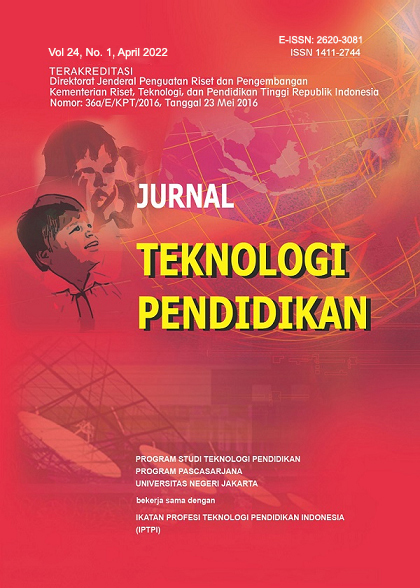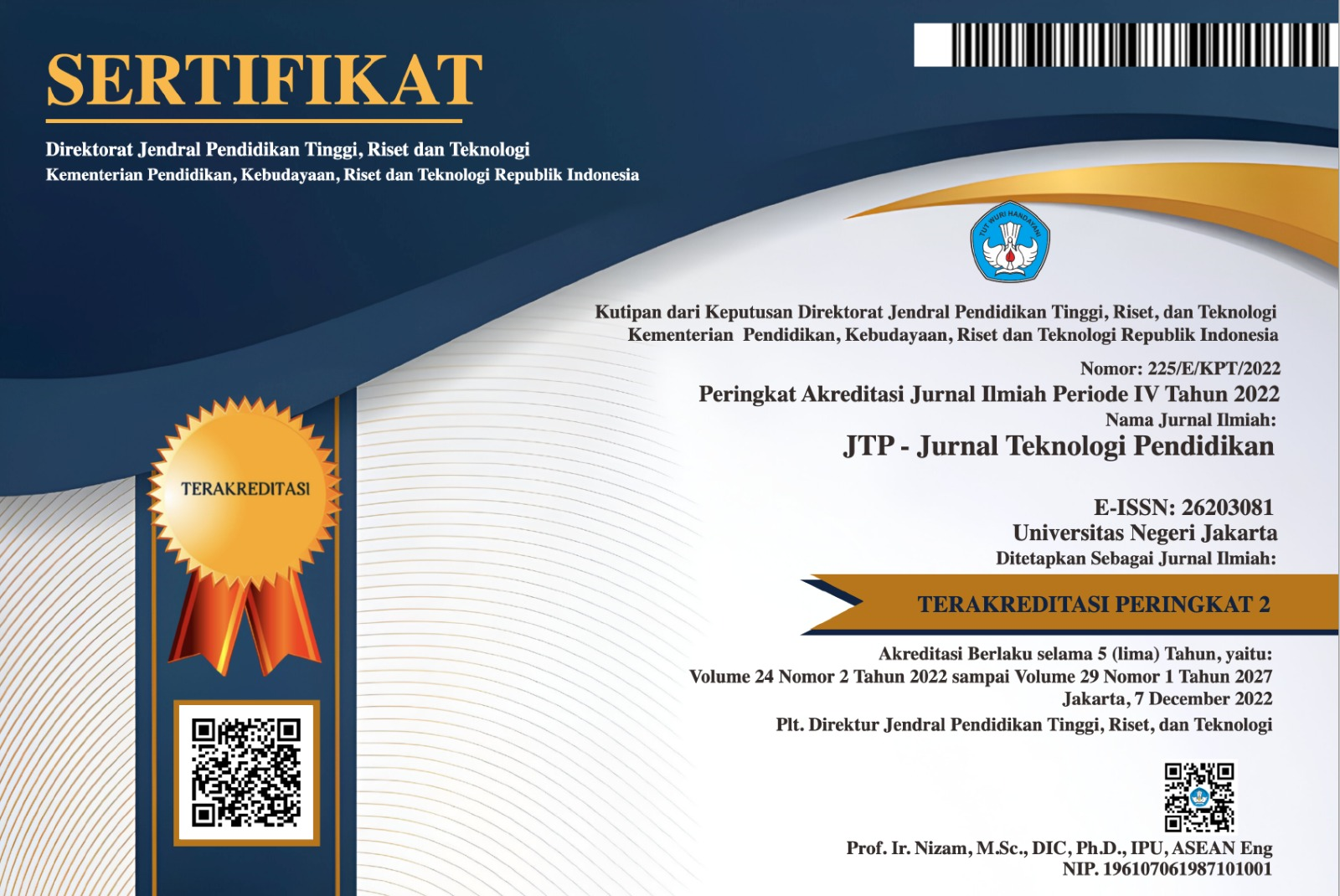The Development of Android-Based Mobile Learning on Materials for Preparation and Proclamation of Indonesian Independence for Class VIII Blind Students at MTs Yaketunis Yogyakarta
DOI:
https://doi.org/10.21009/jtp.v24i1.25314Keywords:
mobile learning, android, blind studentsAbstract
This research aims to find out the feasibility of mobile learning product. This research refers to the development model by Alessi & Trollip. The procedure of mobile learning development consists of (1) planning, (2) designing, and (3) developing that was equipped with component attributes including standards, ongoing evaluation, and project management. The product testing consists of alpha test assessed by media experts, material experts, and instructional experts, while, the beta test involvs impairment students. The data collection techniques used questionnaire. The instrument of data collections used questionnaire. The data analysis techniques used descriptive analysis techniques. The research results showed the feasibility of the product was considered as highly-feasible based on the assessment of media experts, material experts, instructional experts, and the first students’ responses.
References
Boyinbode, O.K., & Akinyede R.O. (2008). Mobile learning: an application of mobile and wireless technologies in nigerian learning system. International Journal of Computers Science and Network Security. Vol.8 no 11, November 2008. Retrieved from http://paper.ijcsns.org/07_book/200811/20081156.pdf
Behera, S.K. (2013). M-Learning: a new learning paradigm. International Journal on New Trends in Education and Their Implications, April 2013, Vol. 4, Issue: 2, Article: 03, ISSN 1309-6249. Retrieved from http://www.ijonte.org/FileUpload/ks63207/File/03.behera.pdf
Carney, S., Engbretson, C., Scammell, K., & Sheppard, V. (2003). Teaching students with visual impairments. _________: Saskatchewan Learning.
Dahar, R.W. (2011). Teori-teori belajar dan pembelajaran. Jakarta: Erlangga.
Degeng, N.S. (2013). Ilmu pembelajaran: klasifikasi variabel untuk pengembangan teori dan penelitian. Bandung: Kalam Hidup.
D'Andrea, M.F., & Farrenkopf, C. (2000). Looking to learn: promoting literacy for students with low vision. New York: AFB PRESS.
Findarno, B. (2013). Pengaruh media audio listening skills peserta didik pada mata pelajaran bahasa inggris kelas viii SMPN 2 Depok, Sleman. E-journal TP. Vol. II, No. 3. Retrieved from http://journal.student.uny.ac.id/jurnal/artikel/4019/93/439
Hake, R. R. (1998). Interaktive-engagement vs traditional methods: a six-thousand-student survey of mechanicstest data for introductory physics course. The American Journal of Physics Research 66, 64-74.
Januszewski, & Molenda, M. (2008), Educational technology: a definition with commentary. New York & London: Lawrence Erlbaum Associates.
Mardapi, D. (2008). Teknik penyusunan instrumen tes dan nontes. Yogyakarta: Mitra Cendekia.
Mayer, R.E. (2009). Multimedia learning: Prinsip-prisip dan aplikasi. Penerjemah: Teguh Wahyu Utomo. Yogyakarta: Pustaka Pelajar.
McQuiggan, S., Kosturko, L., McQuiggan, J., et al. (2015). Mobile learning a handbook for developers, educator and learnners. New Jersey: Wiley.
Rahmawati, I. (2017). Peranan Koleksi Buku Braille dalam Memenuhi Kebutuhan Informasi Siswa MTs LB/A Yaketunis Yogyakarta. Skripsi, Universitas Islam Negeri Sunan Kalijaga Yogyakarta, Yogyakarta.
Reiser, R.A., & Dempsey, J.V. (2007). Trends and issues in instructional design and technology (2nd ed). Upper Saddle River: Pearson Merril Prentice-Hall, Inc.
Republik Indonesia. (2003). Undang-Undang RI nomor 20, tahun 2003, tentang Sistem Pendidikan Nasional.
Sensus, A.I., & Munir, E.S. (2016). Modul Guru Pembelajaran SLB Tunanetra Kelompok Kompetensi G. Bandung: PPPPTK TK dan PLB BANDUNG.
Slavin, R.E. (2000). Educational psychology: theory and practice. Sixth Edition. Boston:
Sunanto, J. (2010). Pengembangan Konsep, Komunikasi, dan Gerak terhadap Anak dengan Hambatan Penglihatan yang disertai Hambatan Lain (MDVI). JASSI_Anakku vol.9 nomor 2. Retrieved from http://ejournal.upi.edu/index.php/jassi/article/viewFile/3921/2805.
Downloads
Published
How to Cite
Issue
Section
License
Jurnal Teknologi Pendidikan is an Open Access Journal. The authors who publish the manuscript in Jurnal Teknologi Pendidikan agree to the following terms.
Attribution-ShareAlike 4.0 International (CC BY-SA 4.0)
-
Attribution — You must give appropriate credit, provide a link to the license, and indicate if changes were made. You may do so in any reasonable manner, but not in any way that suggests the licensor endorses you or your use.
-
ShareAlike — If you remix, transform, or build upon the material, you must distribute your contributions under the same license as the original.
- No additional restrictions — You may not apply legal terms or technological measures that legally restrict others from doing anything the license permits.
Notices:
- You do not have to comply with the license for elements of the material in the public domain or where your use is permitted by an applicable exception or limitation.
- No warranties are given. The license may not give you all of the permissions necessary for your intended use. For example, other rights such as publicity, privacy, or moral rights may limit how you use the material.








